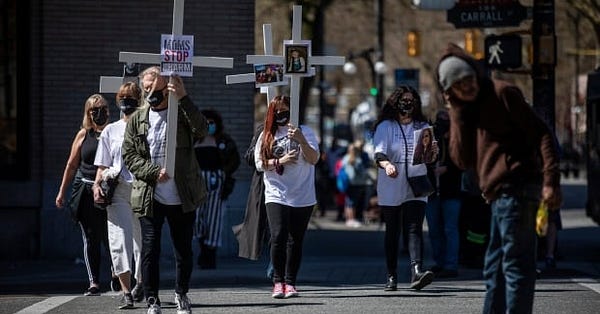The other public health crisis that continues to kill thousands of Canadians
Experts and harm reduction workers have been saying for years that our current preventive measures are not enough to stem the toxic drug crisis. Where do we go from here?
Welcome to the 65th issue of The Supplement, a newsletter that fills in the gaps of your other news intake. This is Alex, one-third of The Supplement team!
Each week, we pick a question submitted by you, our readers. If you’d like to submit a question for a future week, then email us at thesupplementnewsletter@gmail.com or reach out to us on Twitter or Instagram.
If you like what you read each week, consider buying us a coffee ☕
This week, we’re tackling this question: The other public health crisis continues to kill thousands of Canadians.
TL;DR: This week, we want to draw your attention to toxic drug deaths. We have watched the crisis get increasingly worse since the start of the pandemic. BC documented 2,224 deaths in 2021, the deadliest year on record since the province declared a public health emergency over overdoses in 2016. Growing concern has revolved around the rise of contaminants being found in the drug supply. But experts and harm reduction workers have been saying for years that despite preventive measures that have been implemented, like the safe supply program, they have not been enough.
I know we already covered some news that went under the radar because of the trucker convoy last week, but there’s another important story we want to draw your attention to: toxic drug deaths.
In January 2021, we wrote about how much worse the overdose crisis has gotten in Canada since the pandemic started. (Quick answer: very bad.) Then last week, BC confirmed the number for toxic drug deaths for 2021 to be 2,224 — or six deaths a day.
This total figure made 2021 the deadliest year for toxic drug deaths since the province declared the overdose crisis a public health emergency in 2016.

Compared to 2020’s tally, this is a 26 per cent jump. Over 70 per cent of lives lost were people between the ages of 30 and 59 — and most were men. Indigenous people in BC also suffered disproportionately, seeing an overdose rate five times greater than non-Indigenous people.
The province has lost almost 10,000 people to overdoses over the last decade.


A factor that has made the crisis more difficult is the rise in benzodiazepines (often used as a sedative) in the drug supply, especially as they get combined with other contaminants like fentanyl. A major concern is the fact that benzos don't respond to naloxone, which has long been used to reverse overdoses. At the same time, it can render people unconscious for hours, which has reportedly led to robberies and sexual assaults.
Carfentanil, an opioid 100 times more potent than fentanyl, has also been detected more frequently.


In response, BC has been trying to roll out a safe supply of drugs, but researchers and harm reduction workers said the program’s scale has not been large enough. Chief coroner Lisa LaPointe similarly noted that safe supply has been inaccessible, with “hardly anybody” able to reach it and programs located in only Vancouver and Victoria.

For an on-the-ground look at this crisis, the Tyee’s Jen St. Denis and Moira Wyton gave space to harm reduction workers to talk about the challenges they are seeing on the frontline.
Meanwhile, BC has applied to the federal government to decriminalize possession of some illicit drugs last year. But even as the wait continues, advocates have criticized the province’s application as being too limited.

Other news we’re keeping our eyes on:
The trucker convoy is still an ongoing issue, and Prime Minister Justin Trudeau invoked the Emergencies Act yesterday — which has never been done before — to end the protests. Meanwhile, it’s also seeing global offshoots, with foreign content mills boosting the effort.
Some provinces are lifting mask and/or vaccine passport mandates. Following Saskatchewan and Alberta, Manitoba and Ontario have also recently announced changes starting next month.
There is rising fear that Russia will invade Ukraine soon, and Canada is sending weapons and lending $500 million to Ukraine as a result. We wrote more about the stewing conflict in a December explainer.
We touched on this briefly in last week’s newsletter, but protests against a hijab ban for students in Karnataka, India are continuing to spread. Meanwhile, hijab-wearing soccer players are also protesting France’s hijab ban in sports competitions. (Read Shireen Ahmed’s CBC sports column for more analysis, which also reminds us about Quebec’s Bill 21.)
Here’s someone to follow:
We have linked to a lot of work by The Tyee since starting this newsletter, so here’s a formal recommendation to follow the outlet — especially if you want to read some of the best reporting out of Vancouver and BC.
Here’s a story to check out:
Counter-protestors are using a porno-metal song about gay cowboys to troll/disrupt the trucker convoy. I don’t think I need to say more about this story!





